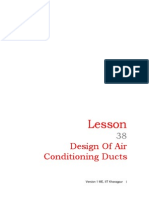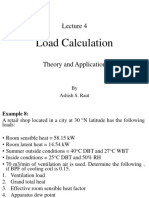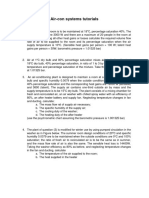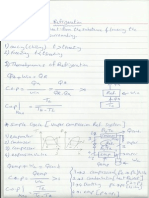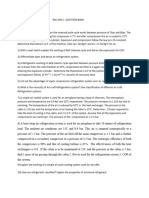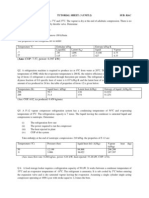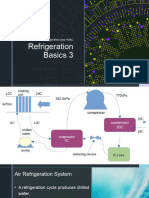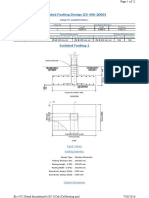Simple (Ideal) Vapor Compression Refrigeration Cycle Problems
Uploaded by
USMAN SARWARSimple (Ideal) Vapor Compression Refrigeration Cycle Problems
Uploaded by
USMAN SARWARSimple (Ideal) Vapor Compression Refrigeration Cycle Problems
Problem # 1
A compressor manufacturing company manufactures one model of compressor used for air
conditioning application. The compressor was tested in a refrigerating calorimeter keeping the evaporator
temperature of 8˚C and condensing temperature of 35˚C using R-22 refrigerant and it was found that the
compressor produced a refrigerating effect of 5TR. Using p-h chart, determine the following:
1) The mass flow rate of the refrigerant
2) Volume flow rate handled by the compressor, volume flow rate per ton of refrigerant
3) Power required by compressor and power required per ton of refrigeration
4) Heat rejected in the condenser
5) COP of the cycle. Assume a simple vapor compression cycle.
Problem # 2
An ammonia refrigeration system in a simple saturation vapor compression cycle to produce ice. The
average temperature of condenser and evaporator are 35˚C and -10˚C, respectively. The plant produces
12 tons of ice everyday using available water at 30C. The ice is at -5˚C. Determine the following:
1. Cooling capacity (refrigeration effect) of the plant in kW
2. Mass flow rate of the refrigerant
3. Temperature of the ammonia vapor at the outlet of the compressor
4. The compressor cylinder diameter and stroke if its volumetric efficiency is 70%, speed 1500 rpm
and L/D = 1.115
5. Theoretical power requirement of the compressor
6. Theoretical COP
Problem # 3
A F-12 refrigeration system operates between the temperature limits of -6˚C and 36˚C. The vapor
is 95% dry at the beginning of the isentropic compression and the liquid leaving the condenser is at 30C.
Assuming actual COP as 50% of the theoretical COP, calculate the amount of ice produced per kWh at 0˚C
from water at 30˚C. Latent heat of ice = 335kJ/kg, specific heat of refrigerant liquid stage = 1.24 kJ/kg-K
Temperature Enthalpy (kJ/kg) Entropy (KJ/kg-K)
˚C Liquid vapor Liquid vapor
-6 30.53 184.94 0.1217 0.6996
36 70.55 201.80 0.2591 0.6836
Problem # 4
28 tonnes of ice at 0˚C is produced per day in an ammonia refrigeration plant. The temperature
range in the compressor is from 25˚C to -15˚C. The refrigerant is dry and saturated at the end of the
compression. If the actual COP is 60% of the theoretical COP, calculate the power required to drive the
compressor.
Assume latent heat of ice = 335 kJ/kg. Use the properties of refrigerant given below:
Temperature Enthalpy (kJ/kg) Entropy (KJ/kg-K)
˚C hf hg sf sg
25 100.04 1319.22 0.3473 4.4852
-15 -54.56 1304.99 -2.1338 5.0585
You might also like
- Refrigeration Pse (Prime Supplementary Exam)No ratings yetRefrigeration Pse (Prime Supplementary Exam)2 pages
- Actual Vapour Compression Cycle, and The Effect of Suction and Discharge Pressure PDFNo ratings yetActual Vapour Compression Cycle, and The Effect of Suction and Discharge Pressure PDF6 pages
- Refrigeration Cycles Vapor Compression CycleNo ratings yetRefrigeration Cycles Vapor Compression Cycle9 pages
- Standard and Actual Vapor Compression Cycle100% (1)Standard and Actual Vapor Compression Cycle19 pages
- Air Conditioning Duct Design-Lecture 38No ratings yetAir Conditioning Duct Design-Lecture 3820 pages
- Freezing Tank Design Conditions:: Freezing Time WT - of Ice Block Per Can (40 Tons of Ice) (48 HRS) 300 LB X 24 HrsNo ratings yetFreezing Tank Design Conditions:: Freezing Time WT - of Ice Block Per Can (40 Tons of Ice) (48 HRS) 300 LB X 24 Hrs20 pages
- The Vapor-Compression Refrigeration CycleNo ratings yetThe Vapor-Compression Refrigeration Cycle17 pages
- 1.1 Industry Profile of CFMTTI, Budni (MP) 1.1.1 Institute Facilities100% (1)1.1 Industry Profile of CFMTTI, Budni (MP) 1.1.1 Institute Facilities50 pages
- Refrigeration and Air-Conditioning: Unit - 4No ratings yetRefrigeration and Air-Conditioning: Unit - 489 pages
- Refrigeration and Air Conditioning Question Bank PDFNo ratings yetRefrigeration and Air Conditioning Question Bank PDF10 pages
- Lesson 5. The Binary Vapor Rankine Power CyclesNo ratings yetLesson 5. The Binary Vapor Rankine Power Cycles1 page
- Fabrication of Air Conditioner Integrated With Water Cooler and Water HeaterNo ratings yetFabrication of Air Conditioner Integrated With Water Cooler and Water Heater7 pages
- Airconditioning: Various Methods of Handling The Air Supplied To A Condition Space50% (2)Airconditioning: Various Methods of Handling The Air Supplied To A Condition Space26 pages
- ME 515A Practice Problem 3 Variable LoadsNo ratings yetME 515A Practice Problem 3 Variable Loads6 pages
- Simple (Ideal) Vapor Compression Refrigeration Cycle ProblemsNo ratings yetSimple (Ideal) Vapor Compression Refrigeration Cycle Problems3 pages
- Refrigeration & Air Conditioning (1) - Sheets Solution100% (3)Refrigeration & Air Conditioning (1) - Sheets Solution25 pages
- RAC First Assignment 2019-20 - VI SemesterNo ratings yetRAC First Assignment 2019-20 - VI Semester7 pages
- Midterm Paper: Date: 20 August 2020 Name of Student: Roll NumberNo ratings yetMidterm Paper: Date: 20 August 2020 Name of Student: Roll Number2 pages
- Vapor Compression Cycle: Problems: DR Rabia ShaukatNo ratings yetVapor Compression Cycle: Problems: DR Rabia Shaukat35 pages
- Department of Mechanical Engineering School of Engineering University of Management and TechnologyNo ratings yetDepartment of Mechanical Engineering School of Engineering University of Management and Technology3 pages
- Question of Social Ethics: 1. What Is The Kohlberg's Theory and Its Level For Moral Development?No ratings yetQuestion of Social Ethics: 1. What Is The Kohlberg's Theory and Its Level For Moral Development?4 pages
- Course Detail On LMS - Production MangementNo ratings yetCourse Detail On LMS - Production Mangement5 pages
- Simple (Ideal) Vapor Compression Refrigeration Cycle ProblemsNo ratings yetSimple (Ideal) Vapor Compression Refrigeration Cycle Problems2 pages
- DR Tipu Sultan: Department of Mechanical Engineering UMT LahoreNo ratings yetDR Tipu Sultan: Department of Mechanical Engineering UMT Lahore62 pages
- ME-333 Refrigeration & Air Conditioning: Mechanical Engineering (6th Semester)No ratings yetME-333 Refrigeration & Air Conditioning: Mechanical Engineering (6th Semester)31 pages
- Giilfi: SPE 36740 Pressure and Results Composition Effect On Wax Precipitation: Experimental Data and ModelNo ratings yetGiilfi: SPE 36740 Pressure and Results Composition Effect On Wax Precipitation: Experimental Data and Model14 pages
- Physics - Physics Form 2 - Zeraki Achievers Exam 6.0 - Question PaperNo ratings yetPhysics - Physics Form 2 - Zeraki Achievers Exam 6.0 - Question Paper16 pages
- Confronting The Challenge of Modeling Cloud and PRNo ratings yetConfronting The Challenge of Modeling Cloud and PR68 pages
- Whats The Difference Between Enthalpy and EntropyNo ratings yetWhats The Difference Between Enthalpy and Entropy12 pages
- Structural Design: Presented by Mohd Khairy Burhanudin Prepared by Ir. Mohammad Soffi MD NohNo ratings yetStructural Design: Presented by Mohd Khairy Burhanudin Prepared by Ir. Mohammad Soffi MD Noh7 pages
- Desalination, 52 (1985) 217-234: Elsevier Science Publishers B.V., Amsterdam - Printed in The Netherlands 217No ratings yetDesalination, 52 (1985) 217-234: Elsevier Science Publishers B.V., Amsterdam - Printed in The Netherlands 21718 pages
- Behaviour of Monopile and Suction Bucket Foundation SystemsNo ratings yetBehaviour of Monopile and Suction Bucket Foundation Systems9 pages






















